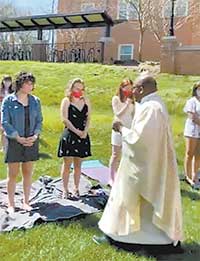 WINSTON-SALEM — Students at Wake Forest University attended in-person Mass at Easter, the first offered since the pandemic began last year. Following the university’s guidelines, Campus Ministry can allow up to 100 people to attend Mass in the space available, following social distancing rules and other public health precautions.
WINSTON-SALEM — Students at Wake Forest University attended in-person Mass at Easter, the first offered since the pandemic began last year. Following the university’s guidelines, Campus Ministry can allow up to 100 people to attend Mass in the space available, following social distancing rules and other public health precautions.
Prior to the outdoor Mass at Easter, students watched Mass streamed live online, and on YouTube and Instagram, offered by chaplain Father Marcel Amadi.
The Diocese of Charlotte’s Campus Ministry program has been diligently adapting to changes in COVID-19 policies among the 21 colleges and universities it serves.
For details, go online to www.catholiconcampus.com.
— Father Marcel Amadi

